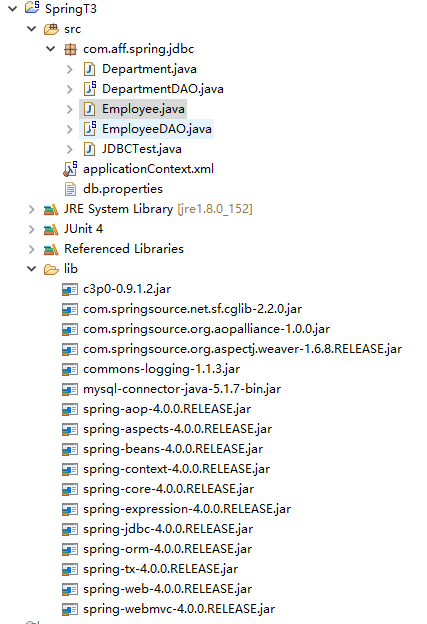1.JdbcTemplate 简化 JDBC 模板查询
①每次使用都创建一个 JdbcTemplate 的新实例, 这种做法效率很低下.
②JdbcTemplate 类被设计成为线程安全的, 所以可以再 IOC 容器中声明它的单个实例, 并将这个实例注入到所有的 DAO 实例中.
③JdbcTemplate 也利用了 Java 1.5 的特定(自动装箱, 泛型, 可变长度等)来简化开发
④Spring JDBC 框架还提供了一个 JdbcDaoSupport 类来简化 DAO 实现. 该类声明了 jdbcTemplate 属性, 它可以从 IOC 容器中注入, 或者自动从数据源中创建.
applicationContext.xml
<?xml version="1.0" encoding="UTF-8"?> <beans xmlns="http://www.springframework.org/schema/beans" xmlns:xsi="http://www.w3.org/2001/XMLSchema-instance" xmlns:context="http://www.springframework.org/schema/context" xsi:schemaLocation="http://www.springframework.org/schema/beans http://www.springframework.org/schema/beans/spring-beans.xsd http://www.springframework.org/schema/context http://www.springframework.org/schema/context/spring-context-4.0.xsd"> <context:component-scan base-package="com.aff.spring.jdbc"></context:component-scan> <!-- 导入资源文件 --> <context:property-placeholder location="classpath:db.properties" /> <!--配置c3p0数据源 --> <bean id="dataSource" class="com.mchange.v2.c3p0.ComboPooledDataSource"> <property name="user" value="${jdbc.user}"></property> <property name="password" value="${jdbc.password}"></property> <property name="jdbcUrl" value="${jdbc.jdbcUrl}"></property> <property name="driverClass" value="${jdbc.driverClass}"></property> <property name="initialPoolSize" value="${jdbc.initPoolSize}"></property> <property name="maxPoolSize" value="${jdbc.maxPoolSize}"></property> </bean> <!--配置Spring 的JdbcTemplate --> <bean id="jdbcTemplate" class="org.springframework.jdbc.core.JdbcTemplate"> <property name="dataSource" ref="dataSource"></property> </bean> <!--配置 NamedParameterJdbcTemplate ,该对象可以使用具名参数, 其没有无参数的构造器,所以必须为其构造器指定参数--> <bean id="namedParameterJdbcTemplate" class="org.springframework.jdbc.core.namedparam.NamedParameterJdbcTemplate"> <constructor-arg ref="dataSource"></constructor-arg> </bean> </beans>
db.properties
jdbc.user=root
jdbc.password=123456
jdbc.driverClass=com.mysql.jdbc.Driver
jdbc.jdbcUrl=jdbc:mysql:///spring
jdbc.initPoolSize=5
jdbc.maxPoolSize=20
JDBCTest.java
package com.aff.spring.jdbc; import java.sql.SQLException; import java.util.ArrayList; import java.util.HashMap; import java.util.List; import javax.sql.DataSource; import org.junit.Test; import org.springframework.context.ApplicationContext; import org.springframework.context.support.ClassPathXmlApplicationContext; import org.springframework.jdbc.core.BeanPropertyRowMapper; import org.springframework.jdbc.core.JdbcTemplate; import org.springframework.jdbc.core.RowMapper; import org.springframework.jdbc.core.namedparam.BeanPropertySqlParameterSource; import org.springframework.jdbc.core.namedparam.NamedParameterJdbcTemplate; import org.springframework.jdbc.core.namedparam.SqlParameterSource; public class JDBCTest { private ApplicationContext ctx = null; private JdbcTemplate jdbcTemplate; private EmployeeDAO employeeDAO; private DepartmentDAO departmentDAO; private NamedParameterJdbcTemplate namedParameterJdbcTemplate; { ctx = new ClassPathXmlApplicationContext("applicationContext.xml"); jdbcTemplate = (JdbcTemplate) ctx.getBean("jdbcTemplate"); employeeDAO = ctx.getBean(EmployeeDAO.class); departmentDAO = ctx.getBean(DepartmentDAO.class); namedParameterJdbcTemplate =ctx.getBean(NamedParameterJdbcTemplate.class); } /** * 使用具名参数时 , 可以使用 NamedParameterJdbcTemplate.update(String sql, SqlParameterSource paramSource) * 进行操作, * 1.SQL参数名和类的属性名一致 * 2.使用 SqlParameterSource 的BeanPropertySqlParameterSource 实现类作为参数 */ @Test public void testNamedParameterJdbcTemplate2(){ String sql ="insert into employees(last_name,email,dept_id) values(:lastName,:email,:deptId)"; Employee employee = new Employee(); employee.setLastName("hxl"); employee.setEmail("hxl@qq.com"); employee.setDeptId(4); SqlParameterSource paramSource = new BeanPropertySqlParameterSource(employee);; namedParameterJdbcTemplate.update(sql, paramSource); } /** * 可以为参数气起名字。 * 好处: 若有多个参数, 则不用去对应位置, 直接对应参数名, 便于维护 * 缺点: 很麻烦 */ @Test public void testNamedParameterJdbcTemplate(){ String sql ="insert into employees(last_name,email,dept_id) values(:ln,:email,:deptid)"; HashMap<String, Object> paramMap = new HashMap<>(); paramMap.put("ln", "hh"); paramMap.put("email", "hh@qq.com"); paramMap.put("deptid", 3); namedParameterJdbcTemplate.update(sql, paramMap); } @Test public void testDepartmentDao(){ System.out.println(departmentDAO.get(1)); //Department [id=1, name=财务部] } @Test public void testEmployeeDAO(){ System.out.println(employeeDAO.get(7)); //Employee [id=7, lastName=jack, email=222@QQ.COM, department=null] } /** * 获取单个列的值, 或做统计查询 * 使用JdbcTemplate.queryForObject(String sql, Class<Long> requiredType) */ @Test public void testQueryForObject2(){ String sql ="select count(id) from employees"; Long count = jdbcTemplate.queryForObject(sql, Long.class); System.out.println(count); //27 } /** * 查到实体类的集合 * 注意 调用的不是queryForList 方法 */ @Test public void testQueryForList(){ String sql = "select id, last_name lastName ,email from employees where id<?"; RowMapper<Employee> rowMapper = new BeanPropertyRowMapper<>(Employee.class); List<Employee> employees = jdbcTemplate.query(sql, rowMapper,3); System.out.println(employees); //[Employee [id=1, lastName=Tom, email=tom@163.com, department=null], //Employee [id=2, lastName=Jerry, email=jerry@126.com, department=null]] } /** * 从数据库中获取一条记录, 实际得到对应的对象 * 注意不是调用JdbcTemplate.queryForObject(String sql, Class<Employee> requiredType, Object... args) * 而是调用.JdbcTemplate.queryForObject(String sql, RowMapper<Employee> rowMapper, Object... args) * 1.其中的 RowMapper 指定如何去映射结果集的行,常用的实现类为BeanPropertyRowMapper * 2.使用SQL 中列的别名 完成类名和类的属性名的映射, 如:last_name lastName * 3.不支持级联属性,JdbcTemplate 到底是一个JDBC 的小工具, 而不是ORM框架 */ @Test public void testQueryForObject(){ String sql = "select id, last_name lastName ,email ,dept_id as"department.id" from employees where id=?"; RowMapper<Employee> rowMapper = new BeanPropertyRowMapper<>(Employee.class); Employee employee = jdbcTemplate.queryForObject(sql, rowMapper,1); System.out.println(employee); //Employee [id=1, lastName=Tom, email=tom@163.com, department=null] } /** * 执行批量的更新: 批量的 insert update delete * 最后一个一个参数 是Object[] 的list 类型 ,因为 修改一条记录需要一个Object数组,多条记录,就需要多个Objec数组,构成的list 集合 */ @Test public void testBatchUpdate() { String sql ="insert into employees(last_name, email, dept_id) values(?,?,?)"; List<Object[]> batchArgs = new ArrayList<Object[]>(); batchArgs.add(new Object[]{"aa","aa@qq.com",2}); batchArgs.add(new Object[]{"bb","bb@qq.com",3}); batchArgs.add(new Object[]{"cc","cc@qq.com",3}); batchArgs.add(new Object[]{"dd","dd@qq.com",3}); //一条记录三个字段构成一个Object数组,多条记录构成Object 数组的集合 jdbcTemplate.batchUpdate(sql, batchArgs); } /** * 执行 insert update delete */ @Test public void testUpdate() { String sql = "update employees set last_name = ? where id=?"; jdbcTemplate.update(sql, "jack", 7); } // 测试连接 @Test public void test() throws SQLException { DataSource dataSource = (DataSource) ctx.getBean("dataSource"); System.out.println(dataSource.getConnection()); } }
EmployeeDAO.java
package com.aff.spring.jdbc; import org.springframework.beans.factory.annotation.Autowired; import org.springframework.jdbc.core.BeanPropertyRowMapper; import org.springframework.jdbc.core.JdbcTemplate; import org.springframework.jdbc.core.RowMapper; import org.springframework.stereotype.Repository; @Repository public class EmployeeDAO { @Autowired private JdbcTemplate jdbcTemplate; public Employee get(Integer id) { String sql = "select id, last_name lastName ,email from employees where id=?"; RowMapper<Employee> rowMapper = new BeanPropertyRowMapper<>(Employee.class); Employee employee = jdbcTemplate.queryForObject(sql, rowMapper, id); return employee; } }
DepartmentDAO.java
package com.aff.spring.jdbc; import javax.sql.DataSource; import org.springframework.beans.factory.annotation.Autowired; import org.springframework.jdbc.core.BeanPropertyRowMapper; import org.springframework.jdbc.core.RowMapper; import org.springframework.jdbc.core.support.JdbcDaoSupport; import org.springframework.stereotype.Repository; //不推荐使用 @Repository public class DepartmentDAO extends JdbcDaoSupport { @Autowired private void setDataSource2(DataSource dataSource) { setDataSource(dataSource); } public Department get(Integer id) { String sql = "select id ,dept_name name from departments where id=?"; RowMapper<Department> rowMapper = new BeanPropertyRowMapper<>(Department.class); return getJdbcTemplate().queryForObject(sql, rowMapper, id); } }
Department.java
package com.aff.spring.jdbc; public class Department { private Integer id ; private String name; public Integer getId() { return id; } public void setId(Integer id) { this.id = id; } public String getName() { return name; } public void setName(String name) { this.name = name; } @Override public String toString() { return "Department [id=" + id + ", name=" + name + "]"; } public Department(Integer id, String name) { super(); this.id = id; this.name = name; } public Department() { super(); // TODO Auto-generated constructor stub } }
Employee.java
package com.aff.spring.jdbc; public class Employee { private Integer id; private String lastName; private String email; private Integer deptId; public Integer getId() { return id; } public void setId(Integer id) { this.id = id; } public String getLastName() { return lastName; } public void setLastName(String lastName) { this.lastName = lastName; } public String getEmail() { return email; } public void setEmail(String email) { this.email = email; } public Integer getDeptId() { return deptId; } public void setDeptId(Integer deptId) { this.deptId = deptId; } @Override public String toString() { return "Employee [id=" + id + ", lastName=" + lastName + ", email=" + email + ", deptId=" + deptId + "]"; } }
目录
